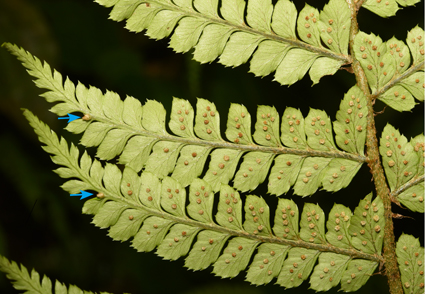Abstract
Three new species of the shield fern genus, Polystichum sunhangii, P. wusugongii, and P. xinfeniae, were described based on morphological and molecular evidence. The new species were discovered in Medog county, Xizang, at elevations ranging from 1200 to 2300 meters. The differences between each new species and their morphologically similar species were discussed. A phylogenetic analysis, based on five plastid markers, confirmed the recognition of the three new species in addition to their morphology.
References
- Ching, R.-C. (1929) Some new species of ferns from Kwangsi, China. Sinensia 1: 1–14.
- Christ, H. (1902) Filices Bodinierianae. Bulletin de l’Académie Internationale de Géographie Botanique 11 (153–154): 189–274.
- Daigobo, S. (1972) Taxonomical studies on the fern genus Polystichum in Japan, Ryukyu, and Taiwan. Science reports of the Tokyo Kyoiku Daigaku, Section B 15: 57–80.
- Dar, G.H. & Khuroo, A.A. (2020) An Introduction to Biodiversity of the Himalaya: Jammu and Kashmir State. In: Dar, G. & Khuroo, A. (Eds.) Biodiversity of the Himalaya: Jammu and Kashmir State. Topics in Biodiversity and Conservation, vol 18. Springer, Singapore, 341 pp. https://doi.org/10.1007/978-981-32-9174-4
- Fan, X.-P., Zhang, L., Zhang, L.-B. & Zhang, L. (2021) Selliguea wusugongii (Polypodiaceae), a new fern species from southeastern Xizang, China based on morphological and molecular evidence. Phytotaxa 480 (1): 57–68. https://doi.org/10.11646/phytotaxa.480.1.5
- Fraser-Jenkins, C., Gandhi, K., Kholia, B. & Kandel, D. (2018) An annotated checklist of Indian Pteridophytes Part-2: Woodsiaceae to Dryopteridaceae. Bishen Singh Mahendra Pal Singh, Dehra Dun, 573 pp.
- Hall, T.A. (1999) BioEdit: a user-friendly biological sequence alignment editor and analysis program for Windows 95/98/NT. Nucleic Acids Symposium Series 41: 95–98.
- Hamilton, F. & Don, D. (1825) Prodromus Florae Nepalensis. Londini, Veneant apud J. Gale, 256 pp.
- Huelsenbeck, J.P. & Ronquist, F. (2001) MRBAYES: Bayesian inference of phylogenetic trees. Bioinformatics 17: 754–755. https://doi.org/10.1093/bioinformatics/17.8.754
- Katoh, K. & Standley, D.M. (2013) MAFFT multiple sequence alignment software version 7: improvements in performance and usability. Molecular Biology and Evolution 30: 772–780. https://doi.org/10.1093/molbev/mst010
- Kreft, H., Jetz, W., Mutke, J. & Barthlott, W. (2010) Contrasting environmental and regional effects on global pteridophyte and seed plant diversity. Ecography 33: 408–419. https://doi.org/10.1111/j.1600-0587.2010.06434.x
- Le Péchon, T., He, H., Zhang, L., Zhou, X.-M., Gao, X.-F. & Zhang, L.-B. (2016) Using a multilocus phylogeny to test morphology-based classifications of Polystichum (Dryopteridaceae), one of the largest fern genera. BMC Evolutionary Biology 16: 1–15. https://doi.org/10.1186/s12862-016-0626-z
- Makino, T. (1902) Observations on the Flora of Japan. (Continued from p. 60.). The Botanical Magazine 16: 87–90. https://doi.org/10.15281/jplantres1887.16.179_10
- Miller, M.A., Pfeiffer, W. & Schwartz, T. (2010) Creating the CIPRES Science Gateway for inference of large phylogenetic trees. In: Proceedings of the Gateway Computing Environments Workshop (GCE), 14 November 2010. New Orleans, LA, pp 1–8. https://doi.org/10.1109/GCE.2010.5676129
- Moore, T. (1858) Index Filicum: a synopsis, with characters, of the genera, and an enumeration of the species of ferns, with synonymes, references, etc. W. Pamplin, London, 204 pp. https://doi.org/10.5962/bhl.title.55301
- Qiu, Y.-L., Xu, K.-W., Ju, W.-B., Zhao, W.-L. & Zhang, L. (2022a) Hymenasplenium tholiformis (Aspleniaceae), a new fern species from southeastern Xizang, China based on morphological and molecular evidence. PhytoKeys 204: 43–56. https://doi.org/10.3897/phytokeys.204.85746
- Qiu, Y.-L., Zhang, L., Zhang, L.-B., Zhou, X.-M. & Zhang, L. (2022b) Athyrium aberrans (Athyriaceae), a new species of the lady ferns from southeastern Xizang, China, based on morphological and molecular evidence. Phytotaxa 533 (3): 165–172. https://doi.org/10.11646/phytotaxa.533.3.2
- Roth, A.W. (1800) Tentamen Florae Germanicae 3. Gleditsch, Leipzig, 578 pp.
- Spicer, R.A. (2017) Tibet, the Himalaya, Asian monsoons and biodiversity–In what ways are they related? Plant Diversity 39: 233–244. https://doi.org/10.1016/j.pld.2017.09.001
- Stamatakis, A., Hoover, P. & Rougemont, J. (2008) A rapid bootstrap algorithm for the RAxML Web servers. Systematic Biology 57: 758–771. https://doi.org/10.1080/10635150802429642
- Tagawa, M. (1934) A review of the genus Cyrtomium of Japan. Acta Phytotaxonomica et Geobotanica 3: 57–67.
- Tagawa, M. (1940) Polystichum of Japan, Korea, and Formosa I. Acta Phytotaxonomica et Geobotanica 9: 119–138.
- Tagawa, M. & Iwatsuki, K. (1968) New or interesting ferns from Thailand 3. Acta Phytotaxonomica et Geobotanica 23: 110–116.
- Thiers, B. (2016) Index Herbariorum: a global directory of public herbaria and associated staff. New York Botanical Garden’s Virtual Herbarium.
- Yang, J.-J., Wan, X., Zhao, W.-L., Liang, Z.-L. & Zhang, L. (2022) Reinstatement of Loxogramme yigongensis (Polypodiaceae), an endemic species from southeastern Xizang, China. Phytotaxa 555 (1): 95–102. https://doi.org/10.11646/phytotaxa.555.1.7
- Zhang, L.-B., Comes, H.P. & Kadereit, J.W. (2001) Phylogeny and quaternary history of the European montane/alpine endemic Soldanella (Primulaceae) based on ITS and AFLP variation. American Journal of Botany 88: 2331–2345. https://doi.org/10.2307/3558393


